|
|
|
|
Products mentioned in this Article
--None--
|
|
|
|
|
|
|
|
|
 |
|
|
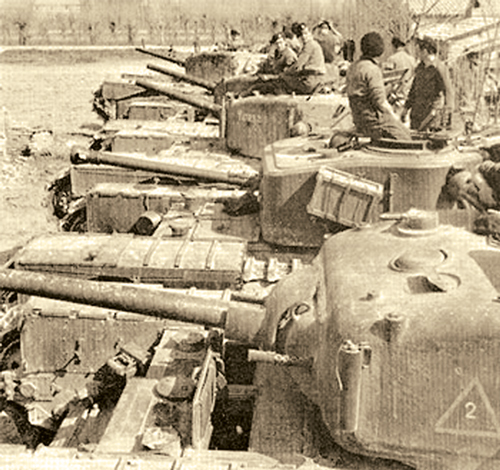 |
Churchills in Italy:
Intelligence Briefing For British Tank Squadrons in Italy, 1944.
The Churchills in North Africa
As a result of the relative success of the six Churchill IIIs that saw action during the Second Battle of Alamein, under the title ‘Kingforce’, the decision was made to dispatch two Army Tank Brigades to Tunisia to support the First Army there. The 25th Army Tank Brigade (consisting of the North Irish Horse, 51st Battalion, Royal Tank Regiment, and 142nd (Suffolk) Regiment, Royal Armoured Corps) was the first unit to arrive in theatre. They arrived just as the Battle for Kasserine Pass was taking place.
|
From 21 February 1943, the Churchills were in action against Rommel’s forces. They developed a reputation for hardiness and an excellent cross-country capability. Indeed one German commander claimed he had been forced to withdraw after being attacked by a ‘mad tank battalion which had scaled impossible heights’. It was in subsequent actions that the North Irish Horse was able to claim the honour of being the first British armoured regiment to knock out a Tiger with direct tank-gun fire.
|
In April 1943, 21st Tank Brigade (consisting of 12th and 48th Battalions, Royal Tank Regiment and 145th (Duke of Wellington’s) Regiment, Royal Armoured Corps) joined the fight as part of the 4th Division. For the first time massed Churchill units were used in operations supporting infantry on the offensive. Actions at Cactus Farm and Sidi Abdallah, against dug in Fallschirmjäger and Tigers saw the loss of 36 Churchill tanks from 12th RTR. On 6 May 1943, both tank brigades fought their last battles in North Africa, and it was just over a year until they next saw action, this time on the European mainland, in Italy.
|
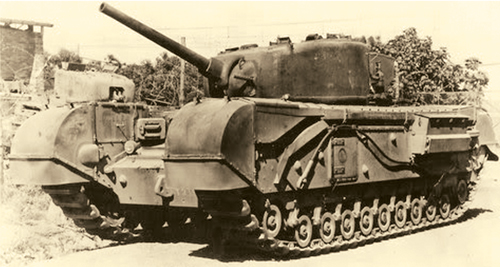 |
In Italy
In April 1944, Churchill tanks joined the Eighth Army on the European mainland when the 25th Tank Brigade and 1st Canadian Division were tasked with smashing a holethrough the Hitler Line, one of the strongest defensive positions in Italy. The German defenders had carefully used the natural features of the land to help make the line near tankproof.
In addition to the well-sited anti-tank guns, mines, anti-tank ditches, bunkers and waiting counterattack forces, a deadly and not previously seen threat was waiting for the Allied attackers. Panther tank turrets, emplaced at ground level on a concrete casemate with excellent fields of fire, could knock-out any Allied tank at distance, and were only visible once they fired.
|
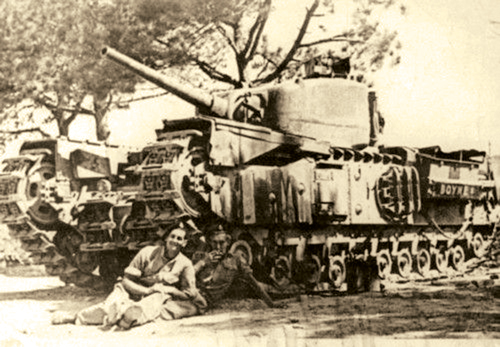 |
On 23 May 1944, after a lengthy bombardment, the
Canadians attacked, supported by the whole brigade with North Irish
Horse on the right flank, 51st RTR in the centre and 142nd RAC on the
left flank. Heavy German artillery, mortar and machine-gun fire soon
forced the infantry into cover and the Churchill squadrons were sent
forward alone to engage the German defenders in a lethal close range
firefight.
As the day progressed, the defenders’ fire was suppressed and the
Canadians were again able to advance. By nightfall the Hitler Line had
been breached and the road to Rome was open. However, the cost in men
and tanks had been high, the North Irish Horse alone losing 24
Churchills. |
The tank brigades then took part in the pursuit of the retreating Germans, playing an important role in that advance. The
Eighth Army was then transferred back to the Adriatic coast at the beginning of August in preparation for operations that
aimed to smash through the Gothic Line on to the Lombardy Plain, considered excellent tank country, where the armoured divisions could hopefully exploit the situation and end the war in Italy by the end of 1944.
|
From 28 August to 17 October both Churchill brigades
fought in support of I Canadian and V British Corps in the
battles for the Gothic Line, the next major defensive line
of fortifications prepared by the Germans, which they had planned to hold on to until at least the end of winter in early 1945. The Gothic Line was similar to the Hitler Line, but was of much greater depth, consisting of what appeared to be a never ending series of well fortified and defended steep ridges that entirely suited defence. Each time the Allies took one ridge, all they would see was another equally well defended German position on the next ridge.
|
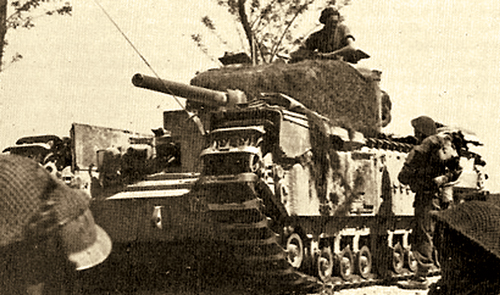 |
Throughout the campaign the Churchill tanks continually provided close support to the infantry over extremely
difficult terrain, which no other tank, Allied or Axis, could have traversed. However, by the time they had fought their
way through the Gothic Line, sunny Italy had become rain sodden, and the thick mud stopped the offensive better
than any German counterattack. The battle for Italy would continue into 1945.
|
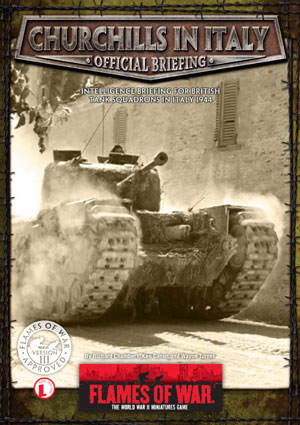 |
British Tank Squadrons in Italy in Flames Of War
The heart and soul of your tank squadron is the British designed and built Churchill tank. Like the great man himself, the Churchill tank has had its fair share of problems, but these have been overcome and the tank is now a reliable fighting machine. In fact, the latest versions are the most heavily-armoured vehicles available to the Allies.
As infantry tankers, however, you are there to support the ‘Poor Bloody Infantry’. They look to you when they come up against dug-in Jerries, machine-guns and even the Panzers. You look to them to keep Jerry’s Panzerfausts and other tank hunters at a safe distance and to help you seize and hold the objectives.
You are part of a unique, highly professional, integrated team, who having rehearsed this combined style of warfare safely in Britain, and are now putting the lessons you’ve learned into practice against the Hun.
Download a PDF version of the Churchills in Italy briefing here... |
Last Updated On Wednesday, April 11, 2012 by Wayne at Battlefront
|
|
|